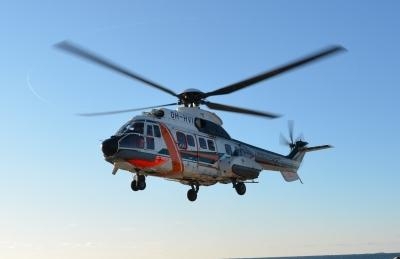But Recommends That AS332 L2 Models Fly Only Non-Passenger Missions
In a meeting held Thursday that continued a review of its decision to recommend the temporary suspension of AS332 L/L1, AS332 L2 and EC225 commercial passenger flights to and from offshore oil and gas installations within the UK, the Step Change in Safety’s Helicopter Safety Steering Group (HSSG) recommended lifting of the temporary suspension of the models. The decision is based on confidence in the helicopters being expressed by European Aviation Safety Agency (EASA), Civil Aviation Authority (CAA), the pilots’ union BALPA, the Norwegian CAA and the helicopter operators themselves, following five days of reviewing safety management systems and processes.

“By taking the time out for safety since the weekend, we have had the opportunity to review key elements of our fleet and better understand the positions of the authorities that determine the airworthiness and operational compliance and safety of our helicopter fleet," said Les Linklater, Step Change in Safety’s team leader. "The result is that there is no evidence to support a continuation of the temporary suspension of the entire Super Puma fleet. As a consequence, the HSSG supports the return to active service of all variants of the Super Puma fleet."
In detail, this means that:
- The fleet of L and L1 helicopters shall return immediately to commercial service,
- The EC225, arguably the most examined helicopter in modern history, shall proceed along its original return to service plan,
- However, in recognition of the understandable sensitivities around the immediate return to service of the L2 fleet (the specific type involved in Friday’s incident), this type will be initially re-introduced for non-passenger revenue operations only. This means non-passenger carrying maintenance, positioning and training flights only.
Linklater said that a "sympathetic approach will be taken to any worker who, during this period, feels unable to fly.”
He said the decision was based on the following observations:
- The helicopter operators have reviewed their own safety management systems and processes and are satisfied that there is no reason to believe there is an inherent mechanical problem with any of the AS332 L/L1, AS332 L2 or EC225 helicopter types,
- The European Aviation Safety Agency and Civil Aviation Authority have not issued any Airworthiness Directives or Operational Directives on these airframes, which positively affirms that there are no safety reasons that support a suspension of flying,
- BALPA, the pilots union, has given its full support to the fleet and positively affirmed that they have no safety concerns with regard to the affected airframes,
- The global picture is that these airframes have continued to fly; moreover, the Norwegian CAA has publicly stated that there are no technical reasons that support a suspension of service. In the UK, AS 332 L/L1s, AS 332 L2s and EC225s have continued to fly on non-commercial and search and rescue operations.

The AAIB has also issued a statement that says the evidence currently available suggests that the helicopter was intact and upright when it entered the water.
“Four people tragically lost their lives on Friday. However there are almost 16,000 people offshore currently, with over 12,000 in the most affected areas (central and northern North Sea)," Linklater said. “Today, there are over 250 people who have spent more than 21 days offshore, this is increasing daily and they and their families are wondering when they are going to get home.
“We have a duty of care to all offshore workers both in terms of their safety and their well-being; we must consider the cumulative risk of the ‘time out’. We must avoid a further tragedy through the introduction of human factor-based risk such as fatigue, stress and other well-being concerns that increase the likelihood of a high consequence – low frequency event."
 Airbus Racer Helicopter Demonstrator First Flight Part of Clean Sky 2 Initiative
Airbus Racer Helicopter Demonstrator First Flight Part of Clean Sky 2 Initiative Diamond's Electric DA40 Finds Fans at Dübendorf
Diamond's Electric DA40 Finds Fans at Dübendorf ANN's Daily Aero-Term (04.23.24): Line Up And Wait (LUAW)
ANN's Daily Aero-Term (04.23.24): Line Up And Wait (LUAW) NTSB Final Report: Extra Flugzeugbau GMBH EA300/L
NTSB Final Report: Extra Flugzeugbau GMBH EA300/L Classic Aero-TV: 'Never Give Up' - Advice From Two of FedEx's Female Captains
Classic Aero-TV: 'Never Give Up' - Advice From Two of FedEx's Female Captains




